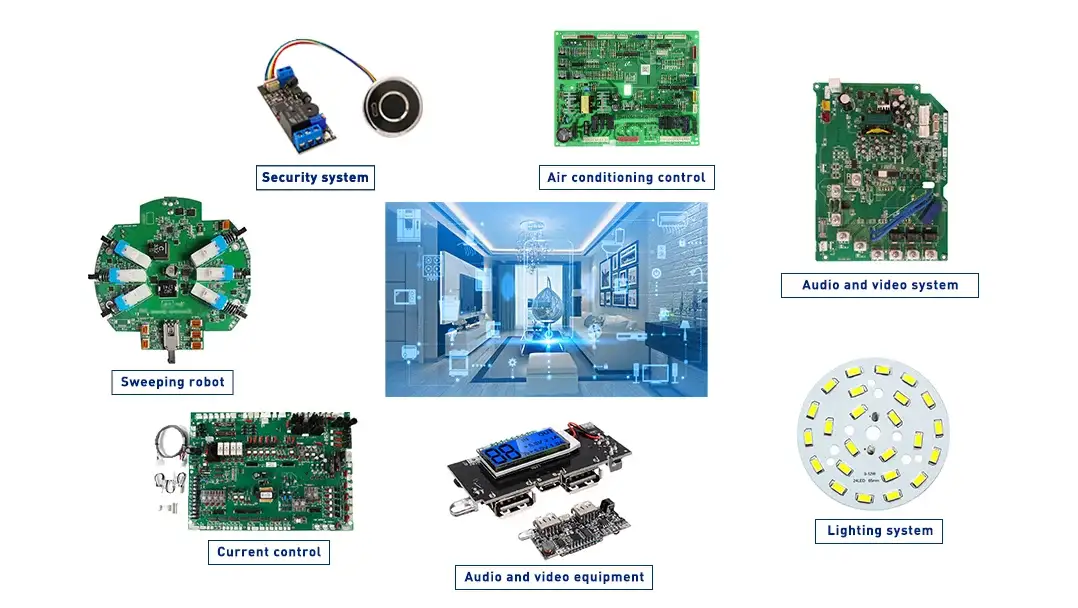smart home electronics
- Home
- smart home electronics
Smart Home PCB Assembly service

Smart Home PCB Applications

Lighting Control
Designed for automation and control of lighting systems in smart homes. They integrate communication modules, microcontrollers, and power management circuits to enable remote control, scheduling, dimming, color changing, and other lighting functions.

Security System
Security systems are the backbone of smart home security solutions. They integrate components such as sensors (motion sensors, door and window sensors), control circuits, communication modules, and alarm triggering circuits. These systems enable intrusion detection, video surveillance, access control, and remote monitoring functions.

Home Automation Hub
Home automation hubs act as the central control unit of smart home systems. They integrate microcontrollers, communication modules (Wi-Fi, Zigbee, Z-Wave, etc.), and user interface components. These PCBAs facilitate the integration, management, and control of multiple smart devices in a smart home ecosystem.

Voice Assistant
Voice assistants combine voice recognition and processing technologies to enable voice-controlled interactions with smart home devices. They integrate microphones, audio processing circuits, communication modules, and AI algorithms to interpret voice commands and control various smart home functions.

Appliance Control
They are used to control and monitor smart appliances in smart homes. They integrate microcontrollers, communication modules, and power management circuits to enable remote control, energy monitoring, scheduling, and status feedback for appliances such as refrigerators, ovens, and washing machines.

Thermostat Control
Thermostat controls are used in smart home heating, ventilation, and air conditioning (HVAC) systems. These PCBAs integrate temperature sensors, communication modules, and control circuits to adjust and automate temperature settings based on user preferences, schedules, or environmental conditions.
Here are some key aspects of Smart Home PCB Assembly:

Types of Smart Home PCB Assembly

Smart Home PCB
Frequent Questions
Smart home PCB integration involves creating compact, reliable PCBs for efficient smart home security devices such as thermostats, lighting systems, and cameras. These PCBs support wireless communication protocols, low-power designs, multiple functions, and include security features to protect data transmission. They are manufactured with high-quality materials to ensure durability and are designed for easy integration and installation in smart home products.
Smart home PCBs can be used in a variety of applications such as smart lighting, thermostats, security systems, appliances, speakers, entertainment systems, HVAC systems, irrigation systems, smart plugs, and sensors. They enable remote control, automation, and integration of devices to improve convenience, safety, and energy efficiency in the home. These PCBs are essential for the seamless operation and connectivity of a smart home environment.
Smart Home PCB quality assurance requirements include adhering to industry standards, using high-quality materials and components, and conducting thorough design verification. Controlled manufacturing processes and extensive testing, such as automated optical inspection (AOI), functional, environmental, electrical, and reliability tests, are essential. Proper documentation and traceability ensure accountability and continuous improvement, guaranteeing reliable and high-performance PCBs for smart home devices.
Smart home PCB design must consider connectivity, power management, compactness, component integration, thermal management, signal integrity, durability, environmental resistance, security, compliance with industry standards, ease of manufacture, and scalability. Addressing these factors ensures the creation of reliable, efficient, and secure smart home devices that meet consumer expectations and regulatory requirements.
Smart home PCBs are characterized by their support for wireless connectivity, compact and efficient design, low power consumption, integrated components, effective thermal management, and signal integrity. They are durable, resistant to environmental factors, and include security features. Additionally, they comply with industry standards, are designed for ease of manufacture, and offer scalability for future upgrades. These characteristics ensure reliable, efficient, and secure smart home devices that meet consumer needs and regulatory requirements.
Smart home PCB assembly types include Surface-Mount Technology (SMT) for high-density designs, Through-Hole Technology (THT) for robust connections, and Mixed Technology for combining both methods. Flexible PCB Assembly suits designs requiring flexibility, while Rigid-Flex PCB Assembly integrates both rigid and flexible sections. Hybrid PCB Assembly combines traditional and advanced technologies. Each type is selected based on the specific design needs, component density, flexibility, and durability requirements of smart home devices.
Smart home PCB products are crucial because they form the backbone of modern home automation systems. They enable connectivity, control, and integration of various smart devices, such as thermostats, lighting systems, security cameras, and appliances. By facilitating wireless communication and efficient power management, smart home PCBs enhance convenience, energy efficiency, and security in everyday life. Their compact design and reliability ensure that smart home devices perform optimally, contributing to a seamless and user-friendly smart home experience.
For smart home PCB assembly, essential files include Gerber files for layout details, Bill of Materials (BOM) for component specifications, Pick and Place files for component placement, and schematic diagrams for circuit design. Additionally, Assembly Drawings guide component placement and soldering, Stencil Files ensure precise solder paste application, Test Specifications outline testing procedures, and Design for Assembly (DFA) Guidelines optimize the assembly process. These files collectively ensure accurate manufacturing, assembly, and testing of smart home PCBs.






